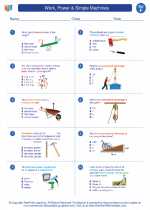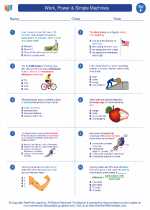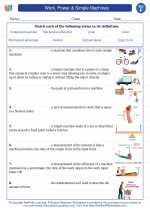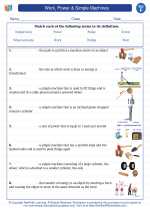Work, Power & Simple Machines
Work, power, and simple machines are fundamental concepts in the field of physics and engineering. Understanding these concepts is essential for understanding how machines and mechanical systems operate. Let's explore each of these concepts in detail:
Work
Work, in the context of physics, is defined as the product of the force applied to an object and the distance over which the force is applied.
The formula for calculating work is:
Work (W) = Force (F) * Distance (d) * cos(θ)
Where:
W = Work
F = Force applied
d = Distance over which the force is applied
θ = Angle between the force and the direction of motion
Power
Power is the rate at which work is done or the rate at which energy is transferred or converted.
The formula for calculating power is:
Power (P) = Work (W) / Time (t)
Where:
P = Power
W = Work
t = Time taken
Simple Machines
Simple machines are devices that can be used to multiply or change the direction of a force. They are the basic mechanical devices that form the basis for more complex machines. There are six types of simple machines:
- Lever
- Pulley
- Wheel and axle
- Inclined plane
- Wedge
- Screw
Each of these simple machines operates on the principles of force, distance, and direction, and they can be combined to create more complex machines to perform specific tasks.
Study Guide
To master the concepts of work, power, and simple machines, here are some key points to focus on:
- Understand the definition of work and how it is calculated using the formula W = F * d * cos(θ).
- Learn the concept of power and how it is related to work, using the formula P = W / t.
- Identify and understand the six types of simple machines, including their basic principles and how they can be used to perform work.
- Practice solving problems related to work, power, and simple machines to reinforce your understanding of the concepts.
By mastering these concepts, you will have a solid foundation in the principles of work, power, and simple machines, which are essential for understanding the mechanics of various mechanical systems and devices.
.◂Science Worksheets and Study Guides Sixth Grade. Work, Power & Simple Machines

 Worksheet/Answer key
Worksheet/Answer key
 Worksheet/Answer key
Worksheet/Answer key
 Vocabulary/Answer key
Vocabulary/Answer key
 Vocabulary/Answer key
Vocabulary/Answer key
